To conserve a threatened plant species (Penthorum chinense Pursh) in Japan, seed germination responses to pretreatment (imbibition and/or chilled), temperature and light, and seed dispersal by water were examined. The seeds collected from abandoned paddy fields in a warm temperate region, central Japan, germinated in light (14 h photoperiod; light 22°C, dark 21°C) after a moist-chilled treatment. After this pretreatment, the seeds germinated well at 10–25°C (optimum temperature 15°C), but did not germinate in darkness even at the optimum temperature. Most of the seeds floated on distilled water, but 20–60% of the seeds that were collected from several populations sank in distilled water, indicating dimorphism in seed dispersal by water. The floating and sunken seeds did not show significant differences in weight and germination rate within a population. The addition of a surface-active agent in distilled water submerged the seeds, indicating that the buoyancy of the seeds is attributable to an oil coating on the seed surface that enhances the interfacial tension on the seeds. Three times the number of seeds sank in river water collected from a rural area than in distilled water. A greater number of seeds also sank in water that had increasing concentrations of linear alkylbenzenesulfonate, which is a major component of synthetic detergents. This suggests that the water dispersal of this species is suppressed by surface-active agents, including detergents, in river water.
Similar content being viewed by others
REFERENCES
Baker G. A. & O’Dowd D. J. (1982) Effects of parent plant density on the production of achene types in the annual Hypochoeris glabra. Journal of Ecology 70: 201–215.
Baskin C. C. & Baskin J. M. (1988) Germination ecophysiology of herbaceous plant species in a temperate region. American Journal of Botany 75: 286–305.
Baskin C. C. & Baskin J. M. (1998) Seeds: Ecology, Biogeography, and Evolution of Dormancy and Germination. Academic Press, San Diego.
Baskin J. M., Baskin C. C. & Spooner D. M. (1989) Role of temperature, light and date: seeds were exhumed from soils on germination of four wetland perennials. Aquatic Botany 35: 387–394.
Black J. N. (1957) The early vegetative growth of three strains of subterranean clover (Trifolium subterraneum L.) in relation to size of seed. Australian Journal of Agricultural Research 8: 1–14.
Cheplick G. P. (1987) The ecology of amphicarpic plants. Trends in Ecology and Evolution 2: 97–101.
Endangered Plant Survey Group (1989) The Red Data Book of Japanese Vascular Plants. Nature Conservation Society of Japan, Tokyo (in Japanese).
Fenner M. (1985) Seed Ecology. Chapman & Hall, London.
Grime J. P. (1979) Plant Strategies and Vegetation Processes. John Wiley & Sons, Chichester.
Harper J. L. & Obeid M. (1967) Influence of seed size and depth of sowing on the establishment and growth of varieties of fiber and oil seed flax. Crop Science 7: 527–532.
Hayashi I. (1979) Secondary succession of herbaceous communities in Japan: Seed germination and shade tolerance of seedlings of the dominants. Bulletin of Yokohama Phytosociological Society of Japan 16: 407–414.
Ishikura N. & Soga Y. (1979) Studies on the ecology and control of perennial weeds, Scirpus in paddy field: 2. Effects of temperature and light during the stratified period on the dormancy–awakening of seeds of Scirpus juncoides Roxb. var. ohwianus T. Koyama. Weed Research, Japan 24: 28–32 (in Japanese with English summary).
Ishiwatari R., Takada H., Yun S.-J. & Matsumoto E. (1983) Alkylbenzene pollution of Tokyo Bay sediments. Nature 301: 599–600.
Kataoka T. & Kim S. Y. (1977) Effects of storage conditions on dormancy-awakening of several weed seeds. Weed Research, Japan 22: 156–158 (in Japanese).
Kato T. & Ota H. (1993) Endangered Wildlife of Japan. Hoikusha Publishing Co., Osaka (in Japanese).
Kimura Y., Suzuki M., Ohno K. & Takaku K. (1999) The life history of Penthorum chinense Pursh and its growth traits in experimentally different water conditions. Bulletin of Water Plant Society, Japan 66: 15–18 (in Japanese).
Kitamura S. & Murata G. (1984) Colored Illustrations of Herbaceous Plants of Japan (Choripetalae). Hoikusha Publishing Co., Osaka (in Japanese).
McEvoy P. B. (1984) Dormancy and dispersal in dimorphic achenes of tansy ragwort, Senecio jacobaea L. (Compositae). Oecologia 61: 160–168.
Miyahara M. (1965) Auto-ecology of barnyardgrass (Echinochloa crus-galli Beauv.). Weed Research, Japan 4: 11–19 (in Japanese).
Ohwi J. & Kitagawa M. (1983) New Flora of Japan. Shibundo, Tokyo (in Japanese).
Redbo-Torstensson P. & Telenius A. (1995) Primary and secondary seed dispersal by wind and water in Spergularia salina. Ecography 18: 230–237.
Ridley H. N. (1930) The Dispersal of Plants Throughout the World. L. Reeve & Co., Ashford.
Salisbury E. J. (1970) The pioneer vegetation of exposed muds and its biological features. Philosophical Transactions of the Royal Society of London Series B 259: 207–255.
Sculthorpe C. D. (1967) The Biology of Aquatic Vascular Plants. Edward Arnold, London.
Takada H. (1993) Distributions of behavior of surfactants and related products in aquatic environments. Journal of Japan Society on Water Environment 16: 308–313 (in Japanese).
Takada H. & Ishiwatari R. (1991) Linear alkylbenzenes (LABs) in urban riverine and coastal sediments and their usefulness as a molecular indicator of domestic wastes. Water Science and Technology 23: 437–446.
Telenius A. & Torstensson P. (1989) The seed dimorphism of Spergularia marina in relation to dispersal by wind and water. Oecologia 80: 206–210.
van der Pijl L. (1982) Principles of Dispersal in Higher Plants, 3rd edn. Springer-Verlag, Berlin.
Venable D. L. & Levin D. A. (1985) Ecology of achene dimorphism in Heterotheca latifolia. I. Achene structure, germination and dispersal. Journal of Ecology 73: 133–145.
Yonemura S., Nasu M., Tazawa R., Henmi I. & Matsubara T. (2000) Preliminary study on restoration of the vulnerable plant species Penthorum chinense. Journal of Japanese Society of Revegetation Technology 25: 317–320 (in Japanese with English summary).
Author information
Authors and Affiliations
Corresponding author
About this article
Cite this article
Ikeda, H., Itoh, K. Germination and water dispersal of seeds from a threatened plant species Penthorum chinense. Ecol Res 16, 99–106 (2001). https://doi.org/10.1046/j.1440-1703.2001.00375.x
Received:
Accepted:
Issue Date:
DOI: https://doi.org/10.1046/j.1440-1703.2001.00375.x




